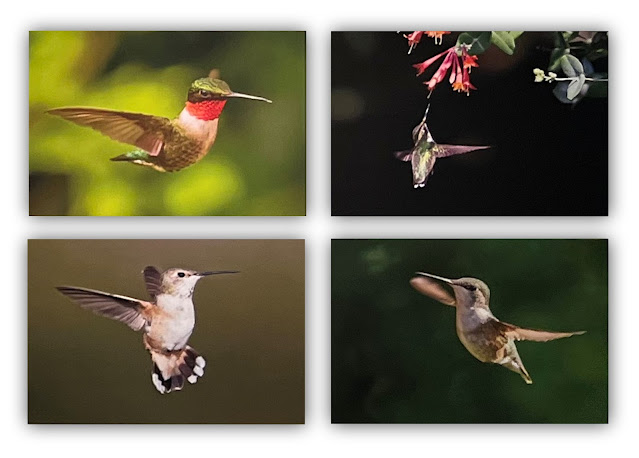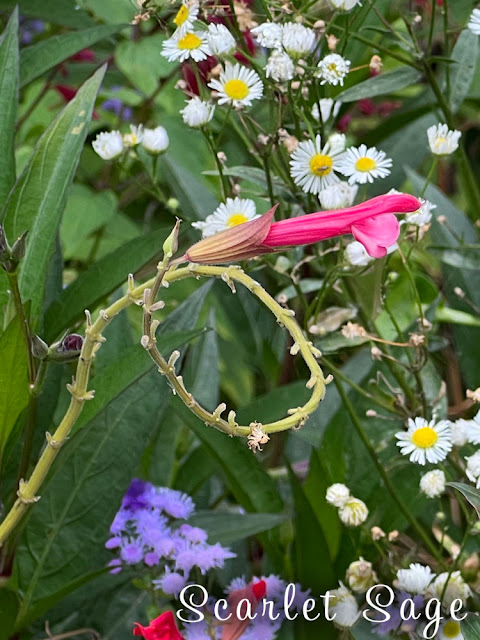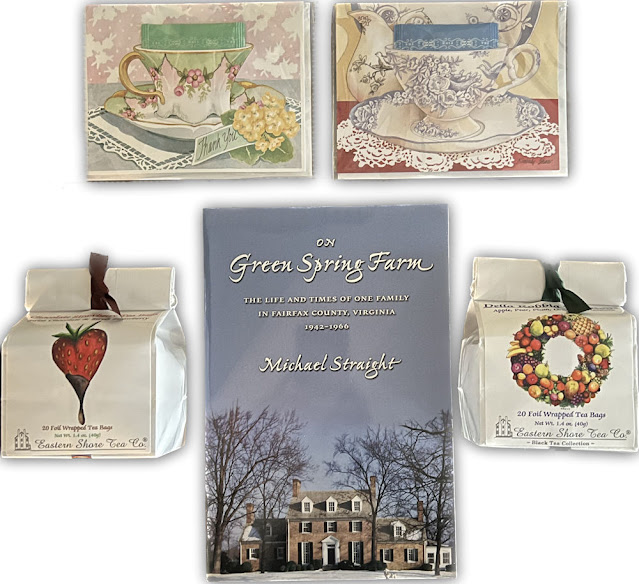
Friday, September 30, 2022
HOVERFLY ON TICKSEED

Thursday, September 29, 2022
NATURE IS...
Angie Weiland-Crosby was born and raised in Southern Maryland. After graduating from college, she traveled the United States for two years before settling in Los Angeles, California. She now lives in Annapolis, Maryland with her family. Her full biography is at the link above.
If you enjoy Fairies, she has just written her first book, "Scarlet Oak". It is available on Amazon at this link and is available in paperback or Kindle.
Wednesday, September 28, 2022
THE HISTORIC HOUSE AT GREEN SPRING GARDENS - HUMMINGBIRD PHOTO EXHIBIT - 9-24-22
I was able to take a few photographs but as we moved on it became more crowded. Amazing hummingbirds taken by equally amazing photographers. I didn't want to disturb those who were enjoying the exhibit and settled down to enjoy them too. (I like to enlarge my own photos in the evenings on my laptop, to study details of any bird I photograph. There were no signs saying not to take photos. I always check.)
I didn't want to disturb those who were enjoying the exhibit and settled down to enjoy them too. (I like to enlarge my own photos in the evenings on my laptop, to study details of any bird I photograph. There were no signs saying not to take photos. I always check.)
I bought a few items in the gift shop, just before we left. Gregg bought me a book on the house's history that I was leafing through, and I also picked up two gift cards and two packets of tea. The cards are the type that a tea bag is included, with a slit in the card so that the tea packet can slip into it. I have seen them before in other places and they have been around for quite a while. You may have seen them too. They make a sweet gift for a family member or friend. A handwritten card and a cup of tea, lovely!
The small room (gift shop area) was filling up with people and we both wanted some fresh air by that time. I was also eager to get to see what was blooming in the garden...
Those anemones were calling me.

I always love the anemones in front of the house. This is the Grape leaf anemone, also known as a Grape leaf windflower. It originated in the Himalayas.
Tuesday, September 27, 2022
GREEN SPRING GARDENS - 9-24-22 - SATURDAY
Lion's tail
I find this a very unusual flower. It reminds me of a colorful creature, with long 'legs'. These clusters grow at intervals on one stem, a few inches above each other. I have shared photos of it on previous visits you can see one of those at this link, with the information I found at the time. It is the 6th photo down in that post.
It goes by the name Lion tail, but is also known as Wild dagga, Lion's ear, Lion's claw or Minaret Flower. Its botanical name is Leonotis leonurus.
It is a very tall perennial garden plant that can grow very fast, up to 6 feet in its first season.
An evergreen shrub, native to the southern regions of Africa and cultivated around the world for its distinctive orange flowers and its tolerance for hot, dry weather. Hummingbirds are drawn to its nectar, also butterflies, though I didn't see any the day I took these photos. It was too cloudy I expect, and though not cold, not too hot either. Lion's tail flowers curve at an angle matched by the beaks of African sunbirds so I read, who feast on the plant's nectar.
It likes full to partial sun and is super easy to take care of, with resistance to almost all pests and diseases. It is a perfect option for gardeners with brown thumbs. And yay, this is perfect for me!
I am happy to say that Gregg and I visited Green Spring Gardens last Saturday. After not visiting over the summer months, we were delighted to get back. There were still lots of flowers still in bloom and we also went inside the old house. They had hummingbird photos on display. Very enjoyable!
And we had a great time walking around the garden. I will be sharing more of what we saw in tomorrow's post.
Thanks for visiting and enjoy the rest of your week.
Monday, September 26, 2022
MONDAY RECIPE POST - CRANBERRY-APPLE CROCKPOT OATMEAL
I will serve this up when we have overnight company and am often asked for the recipe. It is a favorite breakfast (I have also eaten it for supper when I am tired and need an easy supper). What I like is that even when it's just me, I put leftovers in several 1-cup ramekins, wrap them in aluminum foil and freeze them. Easy enough to take out and pop in the microwave. Or if there is more than one person who likes oatmeal, I take out and thaw overnight. Next morning, I can pop them in the oven to warm through.
Cranberry-Apple Crockpot Oatmeal
Serves 4
4 cups water
2 cups old-fashioned oats
2 cups apples, peeled and cut into bite-size pieces
1/2 cup craisins (dried cranberries)
1/8 cup brown sugar
2 tablespoons butter
1/2 teaspoon salt
Using a 5-quart crockpot, spray the inside with non-stick cooking spray.
Add all the ingredients. Stir to combine. Cover and cook on high for 1 hour or on low for 1-1/2 to 2 hours.
Donna suggests preparing this the night ahead. Add apples, craisins and butter to a Ziploc bag and refrigerate. Combine oats, brown sugar and salt to a separate Ziploc bag. Set aside. In the morning pour both bags into slow cooker, add water, stir and turn on.
To reheat oatmeal, add a splash of water or milk to a 1 cup of oatmeal and microwave for 1 minute (more if necessary).
Overnight cooking method: follow recipe as listed, cooking on low for 6-8 hours. Oatmeal will be very soft and porridge-like.
What did I think of this dish? I always enjoy and it is very comforting on a cold morning. It is not something I do just for cold weather, I make it all year round. The addition of the apples and craisins are very yummy. As mentioned above, I put what is left in the freezer, to be taken out whenever I feel like a bowl of nourishing oatmeal.
Saturday, September 24, 2022
SATURDAY MORNING AT THE BIRD FEEDER - THE CARDINAL DEALING WITH A SHORT ATTENTION SPAN.
You will often find me peering outside with camera at the ready. I am waiting for the birds and have to be fast as they don't stay around for long. On this occasion I had the company of a female Cardinal. She was trying to tell me something and I replied...
The idea for this post came to me one day when I was trying to multi-task. I'm not a good multi-tasker, as I have been known to get distracted easily when there is wildlife around.
A quote that tickled my funny bone, as I always enjoyed Daffy Duck and on occasion can relate.
"A fellow with the inventiveness of Albert Einstein but with the attention span of Daffy Duck."
Friday, September 23, 2022
WE MET HIM AT THE MANASSAS NATIONAL BATTLEFIELD PARK...
Thursday, September 22, 2022
A FEW FLOWERS
Warty caltrop, a species of Kallstroemia, and also known as Small-flowered carpetweed

Wednesday, September 21, 2022
A FEW WISE WORDS...
Opinions don’t define your reality.
Everyone’s journey is different.
Overthinking will lead to sadness.
Happiness is found within.
Your thoughts affect your mood.
Smiles are contagious.
Kindness is free.
It’s okay to move on.
and...
Things get better with time.
If you have any opinions about any of these, yay or nay, feel free to leave them in a comment. Always curious about what blogging friends think, and always an education reading others' opinions. Constructive advice is always welcome on my blog.














































